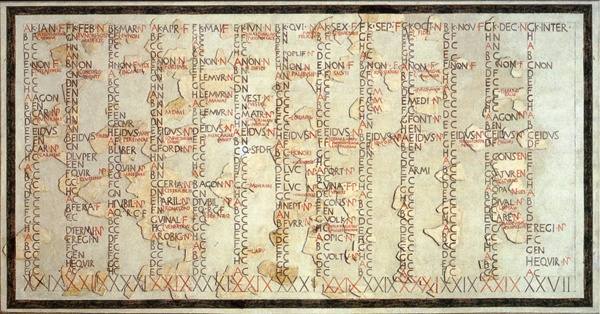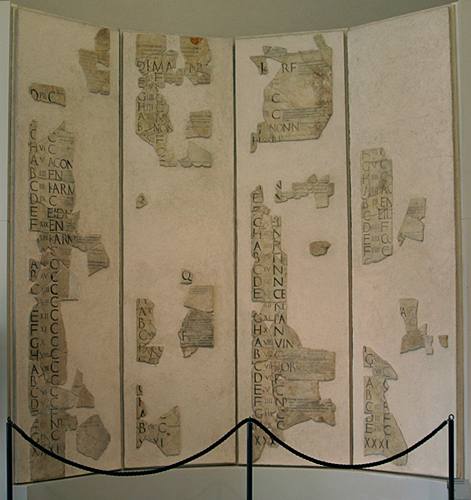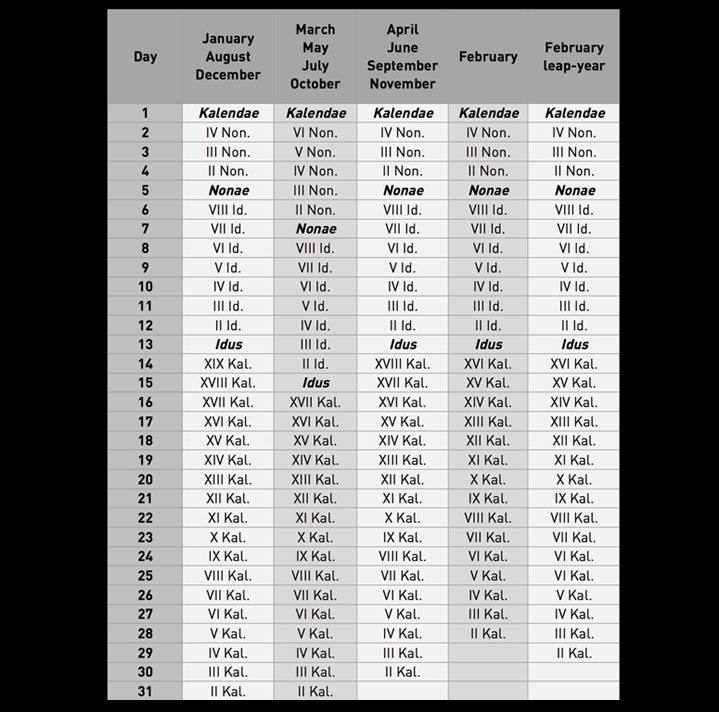Calendar
Originally, ancient cultures used the lunar calendar to count the time.
The primitive Italic peoples had different systems to calculate time, each with their own duration of the year, their own number of months and their own way of distributing the days of each month. However, none of these systems had weeks.
Designation of the years
To indicate the years or dates, the Romans used two different references:
- The year of the foundation of Rome. Year 1 for the Romans is the equivalent of 753 BC in the Christian calendar: trecentesimo quarto anno ab urbe condita, identified the year 304 after the founding of Rome (304 AUC) or, put another way, the year 449 BC.
- The names of the consuls who ruled in a given year: Lucio Domitio Apio Claudio consulibus, identifies the consulate of 54 BC.
Designation of the months
At one point, it was agreed to use a common calendar of 304 days divided into 10 months (6 months of 30 days and 4 of 31 days). The year began in March.
The names of the months were, in this order:
- Martius: in honour of Mars, father of Romulus and Remus (founders of Rome).
- Aprilis: perhaps consecrated to Venus (Apru in Etruscan).
- Maius: dedicated to the goddess Maia, the mother of Mercury, or Maius Iuppiter.
- Iunius: sacred to Juno (Iuno), the wife of Jupiter.
- Quintilis: named for being the fifth month. On the death of Julius Caesar, it became Iulius in his honour.
- Sextilis: sixth month. It then named Augustus after Octavio Augusto.
- Septembris: seventh month (septem: seven).
- Octobris: eighth month (octo: eight).
- Novembris: ninth month (novem: nine).
- Decembris: tenth month (decem: ten).
Later, two new months were added:
- Ianuarius: in honor of Ianus, the god of doors and spirit of the beginning and end.
- Februarius: named due to its relationship with an annual feast of purification called februa and held at this time of year. It was the last month of the year and one which suffered adjustments. In the era of Numa Pompilius, every two years, between 23 and 24 February, a month of 22 or 23 days called Mercedinus (from merces, meaning pay or reward) was included - in fact, the month when servants were paid.
In 153 BC the decision to set January 1 as the start of the year, instead of the traditional March 1, was taken.
After the reforms, the official lunar calendar was out of step with the seasonal course, based on the solar cycle.
Corrective measures did not prevent time lags: calculation errors sometimes caused calendar months and Roman festivals to not correspond with the astronomical seasons.
Designation of the days
To indicate the days of the month, the Romans took for reference only three dates:
- Calendae: they were the 1st of each month.
- Nonae: they were the 5th of each month, except in March, May, July and October where they were day 7.
- Ides: it was the 13th of each month, except in March, May, July and October where they were day 15.
To refer to one of these three fixed times, the Romans put them together with the corresponding month:
Kalendis Ianuariis = Calendae January = January 1
Nonis Octobribus = Nonae October = October
If they wanted to indicate the day earlier or later, the adverb pridie or postridie followed by the fixed date and set month was used.
Pridie nonas Ianuarias = day before the Nonae January = January 4
Postridie idibus Octobribus = day after the Ides October = October 16
If they wanted to indicate any other date, they counted the days until they reached the nearest of the three fixed dates and used the expression ante diem followed by the corresponding ordinal number, plus the fixed date in respect of which the calculation had been made and then the month. To also make the calculation they added the day of the fixed date.
Ante diem sextum Kalendis Martias = sixth day before the Calendae March = February 24
The way of counting days followed the Roman tradition until the Visigoths introduced the custom of numbering them, though this would not be official until Charlemagne.
Designation of the hours
The Romans did not divide the day into 24 hours.
They distributed light time during the day into twelve hours and the dark overnight into four parts called vigiliae.
Thus, both hours and vigils were of variable duration depending on the season: hours were longer in summer than in winter; however, vigilia lasted longer in winter than in summer.
The hours were expressed with ordinals: the hour prima was the first of the day; when marking the end of the day, the sunset, was the twelfth hour.
From the sixth hour (sexta), marking the noon, comes the word "siesta".
The Fasti antiates is the only Roman calendar of the Republic known to date.
In the photographic reconstruction, the abbreviated names of months are arranged on top, preceded by the letter K (kalendae). The Nones (nonae) are listed as the fifth day and the Ides (eidus) as the thirteenth. The intercalary month (intercalaris), inserted every two years, is shown in column XIII. The total number of days in each month is shown at the bottom. Days are listed vertically in the column of each month and are represented by a recurring sequence of letters A to H, where every nine days is identified in red on market day (nundinae).
In addition to these letters, the day incorporating an additional letter (notae dierum) ascribed status: fasti (F), were days when you could perform legal transactions; nefasti (N), days in which they were forbidden; comitiales (C), when public meetings could be convened and held. Sometimes special designations are added: ES (endotercisi) identified divisions into morning, afternoon and evening, taking consideration of nefasti during the first and third periods and fasti during the afternoon; NP probably stands for nefastus publicus. They could also highlight some specific holidays. Large letters marked important festivals, while the smallest letters were used to record brief references such as the name of a deity or the word ludi to highlight the days of games held in honour of certain gods.
Painted directly on a white background in red and black chalk, the Fasti antiates Maiores were found at the site of Nero’s villa at Antium (Anzio).
Except Fasti antiates, all other known calendars are from the Augustan age or later. In all, more than forty calendars survive, some nearly complete, others only in fragments. The biggest is the Fasti Praenestini, measuring approximately 1.83 by 5.49 metres.
The Fasti Praenestini took its name from the city in the east of Rome, in the forum of which the calendar had been placed. It was carved in marble and annotated by the grammarian Verrius Flaco, who was considered "the wisest of all Romans" after Marcus Terentius Varro (Quintilian, Institutio oratoria, X.1.95). It was probably dedicated to Augustus in tribute to his calendar reform (8 AD). The surviving fragments allowed the partial reconstruction of the months of January, March, April and December.
The Julian calendar
Attributed to Romulus himself, the first Roman calendar was determined by the cycles of the moon and the seasons of the agricultural year. The year lasted ten months divided into six months of thirty days and four of thirty-four, for a total of 304 days. It began in March with spring and ended in December with the autumn sowing. The two winter months, when there was no work in the fields, were not counted.
According to Livy (I.19) it was Numa Pompilius, the second king of Rome (715-673 BC), who divided the year into twelve lunar months. Censorinus explains (XX) that 50 days were added to the calendar, in order to incorporate the winter months Ianuarius (January) and Februarius (February), both of twenty-eight days, plus each of the six months of thirty days were reduced by one day. That made a lunar year of 354 days, but because of the Roman superstition about even numbers, one day was added in January to complete the calendar of 355 days. Each month had an odd number of days: Martius (March), Maius (May), Quintilis (July) and Octobris continued to have thirty-one; the other months had twenty-nine except Februarius, which had twenty-eight and was devoted to the rites of atonement and purification (Februa), typical of the last month of the year.
But the sum of the orbits of the Moon completed during the year (354 days, at a rate of 29.5 days for 12 months), did not match the time of the annual orbit of the earth around the sun, a period of about 365,25 days. Thus, 12 lunar months represented a year which was 11 days shorter than the solar year. If this deficit was not corrected, the timing could not remain in sync with the seasons.
The College of Pontifexs was in charge of setting the calendar and the holidays that depended on it.
It was pronounced in February, though without always taking the decision to add in the additional days needed to synchronize the lunar and solar years.
- On the one hand, it was considered that intercalary days were foreboding of bad omens.
- On the other, the calendar could be easily manipulated, which in practice often occurred as a result of partisan political interests: those in official positions could allow elections to be prolonged, advanced or delayed at their convenience. Bibulous, Consul with Caesar in 59 BC, tried to prevent the holding of elections and thwart legislationof his more powerful colleague by declaring holidays on all the days until year's end (Dio, XXXVIII.6.1).
Julius Caesar had been elected Pontifex Maximus in 63 BC, but was so busy in Gaul and then in the civil war that he had only ordered the insertion of one day since he was appointed Proconsul. On February 13, 50 BC, Cicero complained in a letter to Atticus that he still did not know if he would ever add that day in the same month (V. 21). When Caesar finally returned from Egypt in 46 BC and was named dictator, a mismatch of three months had been generated between the seasons and the calendar date. The harvest festivals were celebrated even before the land had been cultivated ("no harvest festivals are held in summer nor those of the harvest in autumn," Suetonius, Life of Iulius, XL.1).
That year, a reformed calendar based on the solar year was presented by Caesar, who had heard about it for the first time during his relationship with Cleopatra (Lucan, Pharsalia, X.187). With the advice of the Alexandrian astronomer Sosígenes, the missing ninety days were inserted, prolonging the ultimus annus confusionis (Macrobius, Saturnalia I.14.3) to 445 days, for which one month of twenty-seven days was inserted after February 24 and they abolished the last four days. In addition, two months more of thirty-three and thirty-four days respectively were inserted between November and December (355 + 27- 4 + 33 + 34 = 445).
To correct the imbalances, it was decided to add one or two additional days to months of 29 days (Ianuarius, Sextilis and Decembris already had 31 days and Aprilis, Junius, Septembris and Novembris, 30 each).
The resulting calendar had approximately 365 days divided into 12 months.
- They were distributed into four nearly equal periods: January (31 days), February (28) and March (31) forming a winter of 90 days (91 in a leap year); April (30) May (31) and June (30), a spring 91 days; July (31) August (31) and September (30), a 92-day summer; and October (31) November (30) and December (31) an autumn of 92 days.
- The winter solstice (Bruma) was established on December 25 (VIII Kal. Jan.). And to conform with this date, the spring equinox, was fixed on March 25 (VIII Kal. Apr.), the summer solstice, June 24 (VIII Kal. Jul.) and the autumnal equinox, September 24 (VIII Kal. Oct.).
As the solar year was about one fourth day longer than the year set by the calendar, they had to interpose an extra day every four years. This was added on February 24, which in the Roman computational system corresponded to the sixth day before the calends of March (ante diem sextum kalendas Martias), so that when February 24 repeated it was called bis sextum.
The reform of Julius Caesar came into force on 1 January 45 BC (the first full moon after Bruma).
When Caesar was assassinated in 44 BC, the month of his birth, Quintilis, was renamed Iulius in his honor. That same year, the priests wrongly decided to enter the leap year every three years instead of four.
When the error was detected, the time lag was corrected in 8 AD by Augustus, who put in the extra day of a leap year for 36 years, thus until 44 AD.
The Julian calendar considered that the year lasted 365.25 days, when in fact the correct figure is 365.242189 (365 days, 5 hours, 48 minutes and 45.16 seconds).
These additional 11 minutes which were added each year supposed that in the 1,257 years between 325 and 1582 an error of about 10 days had been accumulated. This was corrected with the Gregorian calendar.
Implementation of the week
In 321 AD, Emperor Constantine the Great introduced the seven-day week, copied from the Mesopotamian calendar which was based on the planets observed from Earth.
- Dies Solis: Sunday. In 321 AD, Constantine decreed that Sunday would be a compulsory civil rest day (dies dominicus).
- Dies Lunae: Monday.
- Dies Martis: Tuesday.
- Dies Mercurii: Wednesday.
- Dies Iovis: Thursday (Jupiter).
- Dies Veneris: Friday.
- Dies Saturni: Saturday.
This division of the week has been popularized in cultures worldwide.



